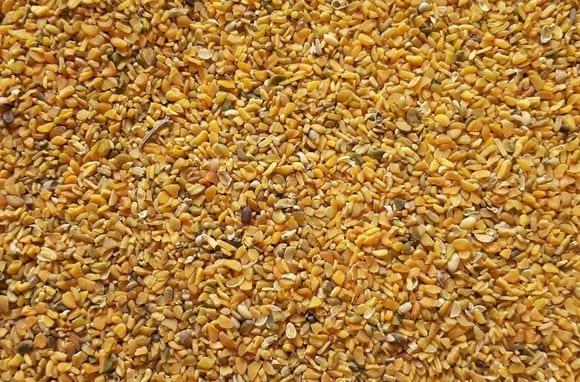Explore all the information on
Feedstuffs
Welcome to the page about Feedstuffs of Engormix; a source of knowledge on Feedstuffs.
Jim Sutter, CEO - U.S. Soybean Export Council (USSEC), explains how the industry exceeded expectations during the pandemic, and discusses his organization's goals and initiatives for the present and future....
Comments : 0
Recommendations: 1
Introduction: Mycotoxins are a large family of toxic fungal metabolites which occur worldwide in various cereals and other feed commodities. During the whole chain from field to feeding, mycotoxins can be produced by molds in plant material. There are numerous mycotoxins which are very toxic to farm animals and may cause different diseases. Therefore they are responsible for reducing animal production. Materials and Methods: To test the occurrence of multiple...
Comments : 0
Recommendations: 0
.jpg&w=3840&q=75)

Lifecycle data on the sustainability of rendered products
Suggested link
Which soya should you use to make fish feed? ...
Comments : 1
Recommendations: 0
Introduction The United Nation’s sustainable development goals aim to “…achieve a better and more sustainable future for all” by addressing “…the global challenges we face, including poverty, inequality, climate change, environmental degradation, peace and justice.” These challenges are interconnected and depend on integrating innovative ideas of several science fields to achieve sustainability, especially in livestock production...
Comments : 0
Recommendations: 1
Constance Cullman (AFIA President & CEO) comments on sustainability, as well as supply chain and labor shortage issues, in this interview during IPPE 2023 in Atlanta, USA....
Comments : 0
Recommendations: 1
.jpg&w=3840&q=75)

Lifecycle data on the sustainability of rendered products
Suggested link
I. INTRODUCTION Both glucose and amino acids are essential for muscle protein deposition and feed conversion efficiency and total tract nitrogen retention was reported to be influenced by protein and starch digestion in broiler chickens (Liu et al., 2013). Liu and Selle (2015) found that 76% of the variation in the feed-conversion ratio (FCR) could be attributed to starch and protein digestion rates in sorghum-based diets. Quadratic relationships between proximal jejunal...
Comments : 1
Recommendations: 1
There are several components of grain and plants that can cause detrimental effects on animal production. These components are commonly known as antinutritional factors. According to their mode of action, anti-nutritional factors can be grouped as follows: Substances that limit or decrease the digestion or metabolism of proteins, ex. lectins and saponins. Substances that interfere or decrease the correct utilization of minerals, ex. phytic acid and oxalic...
Comments : 0
Recommendations: 2
Consumers are basing their purchasing decisions on how the meat, milk, and eggs are raised. With more consumers and animal advocacy organizations pushing to reduce – or eliminate in some cases – the use of antibiotics in livestock production, several challenges have come to light. Many veterinarians and producers are...
Comments : 0
Recommendations: 0
Introduction The gradual increase in the world's poultry production concomitantly increases the need for ingredients to supply protein for diets. Cereals constitute about 60 - 70% of diets to meet the energy requirements of poultry, whereas oilseeds contribute to cover the dietary protein requirements of birds (Senkoylu & Dale, 1999). Soybean meal (SBM) is the main protein source in poultry rations given its high nutritional value. Most of the European and Asian...
Comments : 9
Recommendations: 2
.jpg&w=3840&q=75)

Lifecycle data on the sustainability of rendered products
Suggested link
...
Comments : 0
Recommendations: 0
...
Comments : 0
Recommendations: 0
...
Comments : 0
Recommendations: 0
John Koorn (Laidig Company) discusses the design and specifications for a silo, during FIGAP 2022 in Guadalajara, Mexico....
Comments : 0
Recommendations: 0
.jpg&w=3840&q=75)

Lifecycle data on the sustainability of rendered products
Suggested link
Jeff Cruzen (GONBAR – NECO) comments on the principles, styles and other factors involved in the process of drying grains, during FIGAP 2022 in Guadalajara, Mexico....
Comments : 0
Recommendations: 0
Artificial intelligence (AI) is the field of computer science that deals with the creation of intelligent machines. It encompasses a wide range of techniques, including machine learning, natural language processing and robotics. AI is a rapidly growing technology that has the potential to revolutionise farming and transform the agricultural industry. AI allows us to use and analyse vast amounts of data in ways that were previously unimaginable and make predictions that would have been...
Comments : 0
Recommendations: 0
1. Introduction Mycotoxins are among the most important food safety hazards, based on their presence in agricultural commodities and their potential health impacts (Gruber-Dorninger, Jenkins, & Schatzmayr, 2019; Miraglia, De Santis, & Brera, 2008). A recent study confirms the (earlier) FAO estimate of 25% of mycotoxin occurrence being above European Commission and/or Codex threshold limits, while the prevalence of detectable mycotoxins is up to 60%–80% in all food...
Comments : 0
Recommendations: 0
The ExPress® process, using equipment and know-how from Insta-Pro International, is unique; but why does this matter? First, it does not involve the use of chemicals, like solvents (such as hexane), to extract essentially all the oil from soybeans making it sustainable and a scalable alternative to hexane. Also,...
Comments : 1
Recommendations: 2
.jpg&w=3840&q=75)

Lifecycle data on the sustainability of rendered products
Suggested link
Francesca Mazza (Arm & Hammer) presents her poster on yeast and feed quality, during the Symposium on Gut Health in St. Louis, USA....
Comments : 0
Recommendations: 0
Edible oils obtained from oilseeds such as soybeans and canola are used during the frying foods, and as ingredients in the preparation of pastries and condiments. Edible oils can also be used to improve the texture and flavor of food. Before the oil can be processed into a usable form it is first extracted from the oilseed. While Super-critical Fluid...
Comments : 0
Recommendations: 0
























